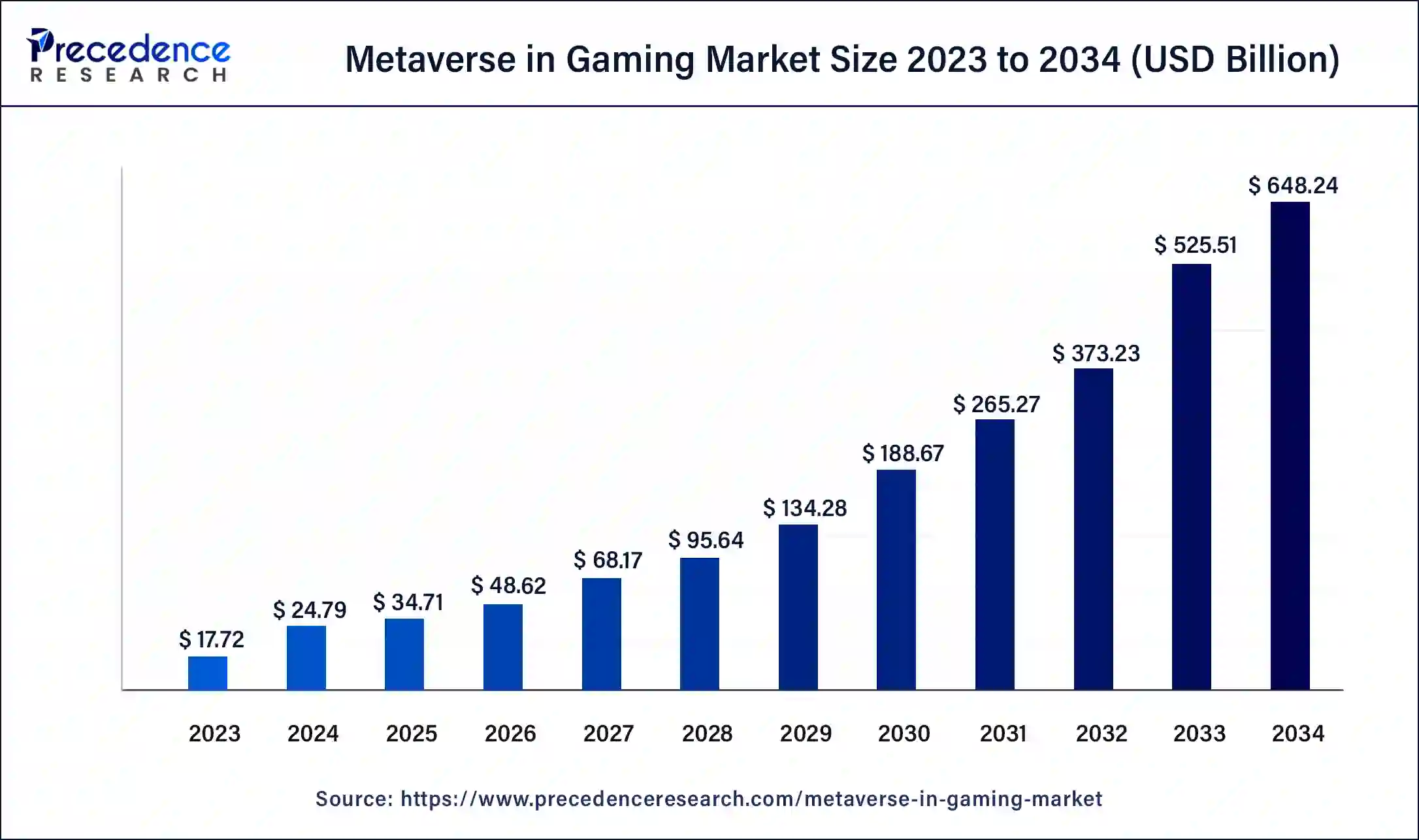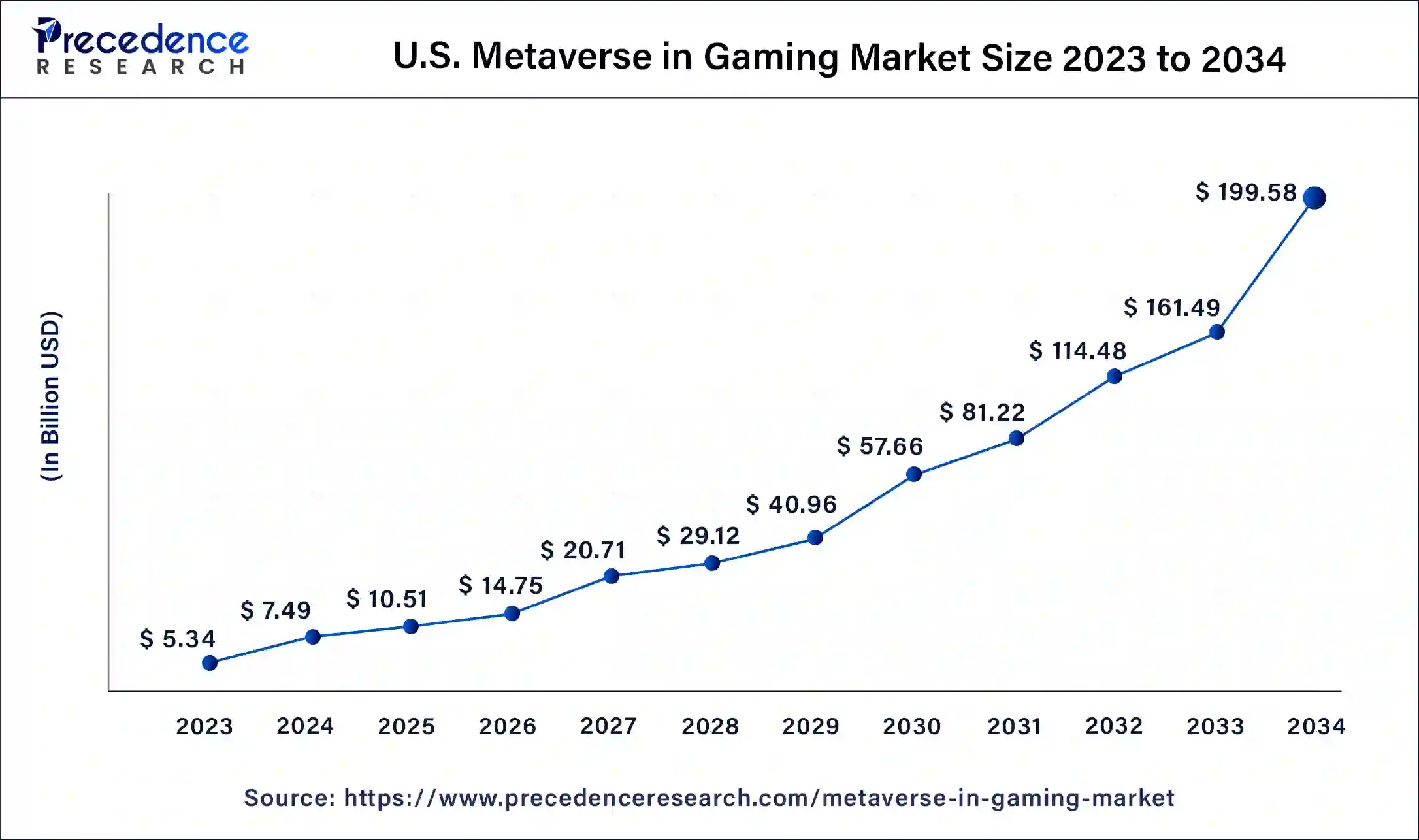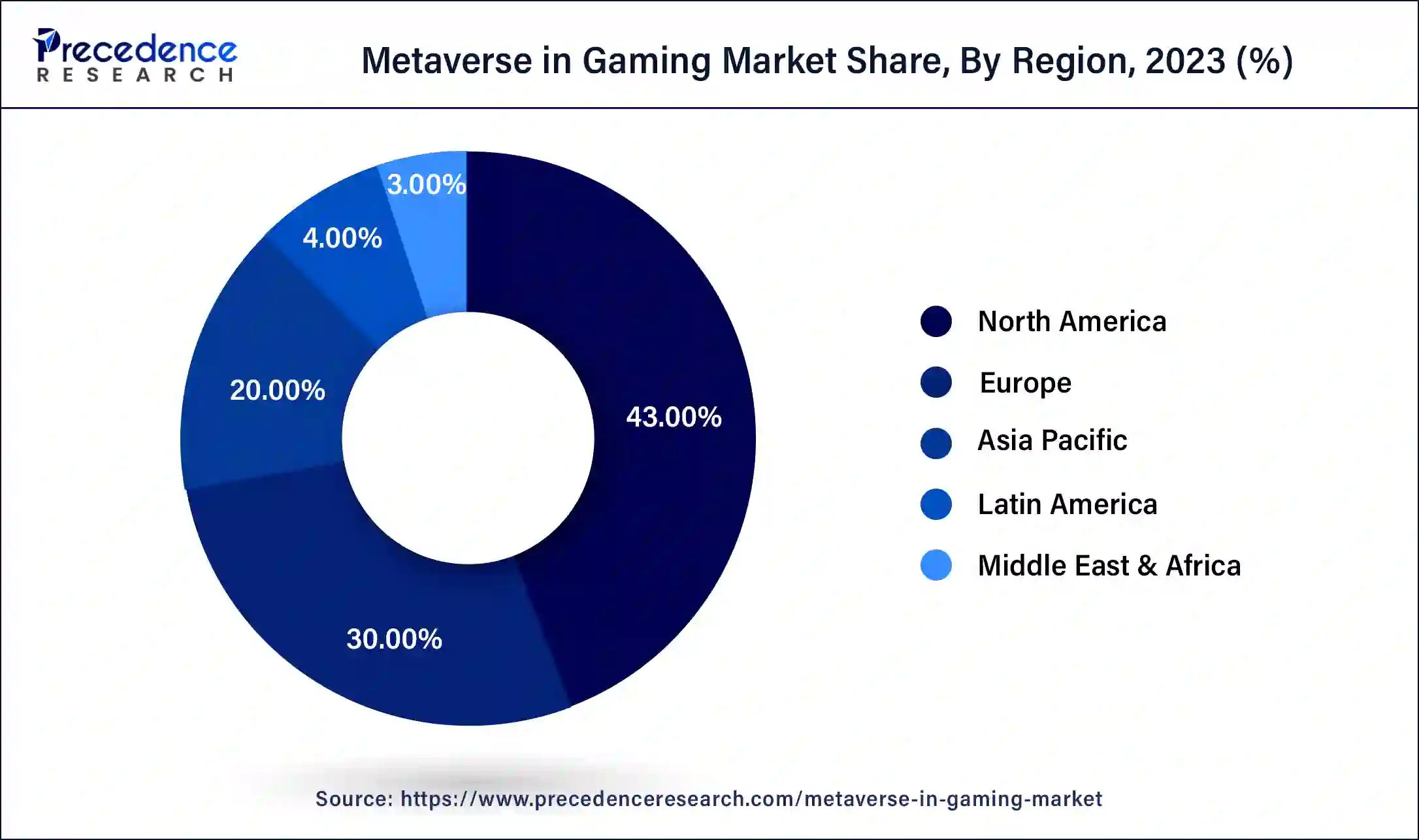February 2024
Metaverse in Gaming Market (By Component: Hardware, Software, Services; By Age Group: Below 21 Years, 21 - 35 Years, 36 - 50 Years, 51 Years and Above; By Technology: AR & VR, MR, Blockchain, Artificial Intelligence, Others; By Genre: Action, Adventure, Role-playing Games, Simulation, Sports and Racing, Strategy, Sandbox, Card and Casino Games, Others) - Global Industry Analysis, Size, Share, Growth, Trends, Regional Outlook, and Forecast 2024-2034
The global metaverse in gaming market size was USD 17.72 billion in 2023, calculated at USD 24.79 billion in 2024 and is expected to reach around USD 648.24 billion by 2034, expanding at a CAGR of 34% from 2024 to 2034. The metaverse in gaming market size reached USD 7.72 billion in 2023.

The U.S. metaverse in gaming market size was valued at USD 5.34 billion in 2023 and is expected to reach around USD 199.58 billion by 2034, growing at a CAGR of 38.86% from 2024 to 2034.

North America holds a share of 43% in 2023 of the metaverse in gaming market owing to its robust technological infrastructure, a high level of internet penetration, and a mature gaming industry. The region is home to key players, major gaming platforms, and significant investments in virtual reality and augmented reality technologies. A tech-savvy population and a culture of early technology adoption further propel North America's prominence. With a well-established gaming ecosystem, substantial financial backing, and a large user base, North America retains a major share, shaping the trajectory of the metaverse gaming market.

Asia-Pacific is set for rapid growth in the metaverse gaming market due to a surge in internet connectivity, a thriving gaming culture, and substantial technological advancements. With a large and engaged user base, the region is witnessing increased investment from both local and international gaming companies. Additionally, supportive government policies and a growing interest in virtual experiences contribute to the optimistic outlook. These factors position Asia-Pacific as a key player in driving the expansion of the metaverse in the gaming industry.
Meanwhile, Europe is experiencing notable growth in the metaverse gaming market due to a combination of factors. The region boasts a strong gaming community, technological innovation, and increasing connectivity. Supportive government initiatives and a focus on fostering the digital economy contribute to this growth. European countries are becoming hubs for metaverse development and investment, attracting both local and global players. With a diverse user base and a culture that values interactive digital experiences, Europe is positioned as a key market for the expanding metaverse in the gaming industry.
The metaverse in gaming refers to a shared, immersive virtual space where users can interact with a computer-generated environment and each other in real time. It goes beyond traditional video games, offering a comprehensive digital universe where players can engage in various activities, from socializing and trading to creating and experiencing unique content. In the metaverse, individuals often use avatars to represent themselves, allowing for a more personalized and dynamic online experience. It aims to blend the physical and digital worlds, providing a seamless and interconnected network of virtual spaces. As technology advances, the metaverse is becoming an exciting frontier for the future of gaming, fostering a sense of community, and enabling new forms of entertainment and collaboration.
Metaverse in Gaming Market Data and Statistics
| Report Coverage | Details |
| Global Market Size by 2034 | USD 648.24 Billion |
| Global Market Size in 2023 | USD 17.72 Billion |
| Global Market Size in 2024 | USD 24.79 Billion |
| Growth Rate from 2024 to 2034 | CAGR of 34% |
| Largest Market | North America |
| Base Year | 2023 |
| Forecast Period | 2024 to 2033 |
| Segments Covered | Component, Age Group, Technology, Genre, and Region |
| Regions Covered | North America, Europe, Asia-Pacific, Latin America, and Middle East & Africa |
Increased connectivity and internet speeds
Increased connectivity and faster internet speeds play a pivotal role in driving the demand for the metaverse in the gaming market. As internet infrastructure improves globally, gamers can enjoy a more seamless and responsive experience within the virtual worlds of the metaverse. Faster internet ensures quicker data transfer, reducing lag and enhancing the overall gaming experience. This improved connectivity opens doors to more immersive and interactive gameplay, attracting a larger audience to explore the metaverse.
Additionally, heightened connectivity enables real-time multiplayer interactions and collaborative gaming experiences, fostering a sense of community within the metaverse. Gamers can engage in social activities, trade virtual assets, and participate in large-scale events with minimal disruptions. As the demand for immersive gaming grows, the reliance on robust internet connectivity becomes a key factor in sustaining and expanding the metaverse, creating a dynamic and engaging virtual space for users worldwide.
Regulatory uncertainty
Regulatory uncertainty poses a significant restraint on the market demand for the metaverse in gaming. The evolving nature of the metaverse raises questions for regulators, creating a challenging environment for developers and users alike. Unclear or restrictive regulations can impede investment and development, as companies may hesitate to fully commit to projects without a clear understanding of the regulatory landscape.
Moreover, the lack of consistent regulations can lead to confusion regarding issues like user privacy, intellectual property rights, and virtual asset ownership. This uncertainty may deter potential users and investors, hindering the metaverse's widespread adoption. For the market to thrive, there is a pressing need for transparent and well-defined regulatory frameworks that can provide clarity and confidence to stakeholders, fostering a conducive environment for the continued growth of the metaverse in the gaming industry.
Economic growth and job creation
Economic growth and job creation stand out as significant opportunities in the metaverse within the gaming market. Initiatives, like Dubai's metaverse strategy, exemplify how the expansion of the gaming metaverse can become a catalyst for economic development. The injection of billions into the economy and the creation of thousands of new jobs over a few years not only benefit the gaming industry but contribute positively to the overall economic landscape.
As the metaverse continues to grow, it opens avenues for diverse job roles, from content creation and development to community management. This not only enhances the employment landscape but also fosters innovation and skills development within the gaming sector. The metaverse's potential to generate economic value and employment opportunities positions it as a key player in shaping the future of both the gaming industry and broader economies.
The hardware segment held the highest market share of 44% in 2023. In the metaverse in gaming market, the hardware segment encompasses the physical components essential for immersive experiences, such as VR headsets, haptic devices, and powerful GPUs. Recent trends highlight a surge in demand for advanced hardware, driven by the quest for more realistic virtual environments. The emergence of cutting-edge devices with enhanced features, like improved resolution and sensory feedback, signifies a growing focus on delivering a seamless and high-quality gaming experience within the metaverse, reflecting the dynamic evolution of hardware components in this vibrant and expanding market.
The services segment is anticipated to grow rapidly at a significant CAGR of 41.8% during the projected period. In the metaverse in gaming market, the services component encompasses a range of offerings supporting users and developers. These services may include virtual world creation, maintenance, and user support, as well as platform integration and customization. A notable trend is the surge in demand for specialized metaverse consulting services, assisting companies in navigating the evolving landscape. As metaverse adoption grows, services facilitating seamless user experiences, content creation, and technical assistance become integral, reflecting the market's emphasis on providing comprehensive and user-centric solutions.
The 21-35 years segment has held 37% market share in 2023. The 21-35 years age group represents a crucial segment in the metaverse in gaming market, comprising tech-savvy individuals seeking immersive and social gaming experiences. This demographic is driving trends such as increased demand for multiplayer interactions, virtual events, and diverse gaming content within the metaverse. As this age group embraces advanced technologies, game developers are focusing on creating dynamic and socially engaging experiences to cater to their preferences, shaping the evolution of the metaverse in gaming. The 21-35 age range is a key driver in the market's growth, influencing the design and features of metaverse gaming platforms.
The 36 - 50 years segment is anticipated to witness rapid growth over the projected period. The 36-50 years age group in the metaverse gaming market represents a segment of seasoned gamers seeking immersive experiences. This demographic values nostalgia, often engaging in retro-themed games within the metaverse. As a financially stable group, they contribute to the market by investing in virtual assets and experiences. Trends show a growing interest in social gaming platforms, where this segment enjoys connecting with peers, participating in virtual events, and exploring diverse gaming content, making them a key demographic shaping the evolving landscape of the metaverse in gaming.
The AR and VR segment has held 43% market share in 2023. In the metaverse in gaming market, augmented reality and virtual reality are transformative technologies. AR overlays digital elements onto the real world, enhancing gamers' surroundings, while VR immerses users in entirely virtual environments. The trend indicates a growing emphasis on enhancing user experiences through more immersive gameplay. With advancements in AR and VR technologies, game developers are increasingly leveraging these tools to create engaging, lifelike experiences within the metaverse, enhancing the overall appeal and interactivity for players.
The artificial intelligence (AI) segment is anticipated to witness the fastest growth over the projected period. In the metaverse gaming market, the artificial intelligence (AI) segment involves the integration of advanced AI technologies to enhance virtual environments, character behaviors, and overall gaming experiences. AI-driven NPCs (non-player characters), dynamic storytelling, and personalized gaming interactions are key components. Trends in this segment include the rise of AI-powered procedural content generation, creating dynamically evolving virtual worlds. Additionally, AI-driven adaptive difficulty levels and personalized gaming recommendations contribute to a more immersive and tailored gaming experience within the evolving landscape of the metaverse.
The adventure genre segment has held a 31% market share in 2023. In the metaverse gaming market, the adventure genre segment immerses players in narrative-driven experiences, often involving exploration, puzzles, and quests. Trends indicate a surge in demand for expansive and dynamic virtual worlds, offering players the freedom to shape their narratives. The metaverse's interconnected nature allows for collaborative adventures, where users can share quests and challenges. This genre's growth is driven by the desire for rich storytelling and interactive environments, creating a virtual landscape where players can embark on captivating journeys with endless possibilities.
The sandbox genre segment is anticipated to grow rapidly over the projected period. The sandbox genre in the metaverse gaming market refers to open-world, player-driven environments allowing users to shape the virtual landscape. Trends indicate a surge in popularity as players seek creative freedom. Games within this genre often feature user-generated content, encouraging player collaboration and innovation. The metaverse's sandbox segment is witnessing a rise in diverse experiences, from building virtual worlds to crafting unique narratives. This trend aligns with the growing demand for immersive and customizable gaming experiences, emphasizing player agency in shaping the evolving landscape of the metaverse.
Segments Covered in the Report
By Component
By Age Group
By Technology
By Genre
By Geography
For inquiries regarding discounts, bulk purchases, or customization requests, please contact us at sales@precedenceresearch.com
No cookie-cutter, only authentic analysis – take the 1st step to become a Precedence Research client
February 2024
February 2025
January 2025
February 2025